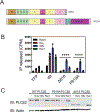Activation of Phospholipase C β by Gβγ and Gαq Involves C-Terminal Rearrangement to Release Autoinhibition
- PMID: 32402248
- PMCID: PMC7891876
- DOI: 10.1016/j.str.2020.04.012
Activation of Phospholipase C β by Gβγ and Gαq Involves C-Terminal Rearrangement to Release Autoinhibition
Abstract
Phospholipase C (PLC) enzymes hydrolyze phosphoinositide lipids to inositol phosphates and diacylglycerol. Direct activation of PLCβ by Gαq and/or Gβγ subunits mediates signaling by Gq and some Gi coupled G-protein-coupled receptors (GPCRs), respectively. PLCβ isoforms contain a unique C-terminal extension, consisting of proximal and distal C-terminal domains (CTDs) separated by a flexible linker. The structure of PLCβ3 bound to Gαq is known, however, for both Gαq and Gβγ; the mechanism for PLCβ activation on membranes is unknown. We examined PLCβ2 dynamics on membranes using hydrogen-deuterium exchange mass spectrometry (HDX-MS). Gβγ caused a robust increase in dynamics of the distal C-terminal domain (CTD). Gαq showed decreased deuterium incorporation at the Gαq binding site on PLCβ. In vitro Gβγ-dependent activation of PLC is inhibited by the distal CTD. The results suggest that disruption of autoinhibitory interactions with the CTD leads to increased PLCβ hydrolase activity.
Keywords: G protein; G-protein-coupled receptor; GPCR; Gαq; Gβγ; HDX-MS; hydrogen-deuterium exchange; lipids; membrane interactions; phospholipase C; protein dynamics; signal transduction.
Copyright © 2020 Elsevier Ltd. All rights reserved.
Conflict of interest statement
Declaration of Interests The authors declare no competing interests.
Figures







Similar articles
-
Intrinsic Pleckstrin Homology (PH) Domain Motion in Phospholipase C-β Exposes a Gβγ Protein Binding Site.J Biol Chem. 2016 May 20;291(21):11394-406. doi: 10.1074/jbc.M116.723940. Epub 2016 Mar 21. J Biol Chem. 2016. PMID: 27002154 Free PMC article.
-
Gβγ signaling to the chemotactic effector P-REX1 and mammalian cell migration is directly regulated by Gαq and Gα13 proteins.J Biol Chem. 2019 Jan 11;294(2):531-546. doi: 10.1074/jbc.RA118.006254. Epub 2018 Nov 16. J Biol Chem. 2019. PMID: 30446620 Free PMC article.
-
Synergistic Ca2+ responses by G{alpha}i- and G{alpha}q-coupled G-protein-coupled receptors require a single PLC{beta} isoform that is sensitive to both G{beta}{gamma} and G{alpha}q.J Biol Chem. 2011 Jan 14;286(2):942-51. doi: 10.1074/jbc.M110.198200. Epub 2010 Oct 29. J Biol Chem. 2011. PMID: 21036901 Free PMC article.
-
Phospholipase Cβ connects G protein signaling with RNA interference.Adv Biol Regul. 2016 May;61:51-7. doi: 10.1016/j.jbior.2015.11.006. Epub 2015 Dec 2. Adv Biol Regul. 2016. PMID: 26746047 Free PMC article. Review.
-
Molecular regulation of PLCβ signaling.Methods Enzymol. 2023;682:17-52. doi: 10.1016/bs.mie.2023.01.001. Epub 2023 Feb 22. Methods Enzymol. 2023. PMID: 36948701 Free PMC article. Review.
Cited by
-
Driving Therapeutic Innovation in Neurodegenerative Disease With Hydrogen Deuterium eXchange Mass Spectrometry.Mol Cell Proteomics. 2025 Jun 20;24(8):101017. doi: 10.1016/j.mcpro.2025.101017. Online ahead of print. Mol Cell Proteomics. 2025. PMID: 40544994 Free PMC article. Review.
-
Activation Mechanisms and Diverse Functions of Mammalian Phospholipase C.Biomolecules. 2023 May 31;13(6):915. doi: 10.3390/biom13060915. Biomolecules. 2023. PMID: 37371495 Free PMC article. Review.
-
Dobutamine, Epinephrine, and Milrinone Accelerate Particle Transport Velocity in Murine Tracheal Epithelium via Ca2+ Release from Caffeine-Sensitive Internal Stores.Cells. 2025 Feb 5;14(3):228. doi: 10.3390/cells14030228. Cells. 2025. PMID: 39937019 Free PMC article.
-
Structure and regulation of phospholipase Cβ and ε at the membrane.Chem Phys Lipids. 2021 Mar;235:105050. doi: 10.1016/j.chemphyslip.2021.105050. Epub 2021 Jan 7. Chem Phys Lipids. 2021. PMID: 33422547 Free PMC article. Review.
-
Characterization of the membrane interactions of phospholipase Cγ reveals key features of the active enzyme.Sci Adv. 2022 Jun 24;8(25):eabp9688. doi: 10.1126/sciadv.abp9688. Epub 2022 Jun 24. Sci Adv. 2022. PMID: 35749497 Free PMC article.
References
-
- Adjobo-Hermans MJ, Crosby KC, Putyrski M, Bhageloe A, van Weeren L, Schultz C, Goedhart J, and Gadella TW Jr. (2013). PLCβ isoforms differ in their subcellular location and their CT-domain dependent interaction with Gαq. Cell Signal 25, 255–263. - PubMed
-
- Berridge MJ (1987). Inositol tisphosphate and diacylglycerol: two interacting second messengers. Ann Rev Biochem 56, 159–193. - PubMed
-
- Bonacci TM, Ghosh M, Malik S, and Smrcka AV (2005). Regulatory interactions between the amino terminus of G-protein βγ subunits and the catalytic domain of PLCβ2. J Biol Chem 280, 10174–10181. - PubMed
Publication types
MeSH terms
Substances
Grants and funding
LinkOut - more resources
Full Text Sources

